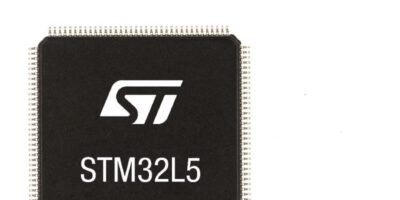Low-power microcontrollers secure the IoT
Building on Arm TrustZone hardware-based cyber protection for resource-constrained connected devices, the STM32L5 microcontroller has an Arm Cortex-M33 core.
The Cortex-M33 boosts protection for small devices by integrating Arm’s TrustZone hardware-based security, explains ST. The STM32L5-series microcontrollers add further enhancements including software isolation, secure boot, key storage, and hardware cryptographic accelerators. They also provide rich functionality, says the company, and long run-times powered by coin cells or energy harvesting.
They consume as little as 33nA in shutdown mode and achieving 402 ULPMark-CP in the EEMBC ULPBench. The microcontrollers also integrate low power techniques such as adaptive voltage scaling, real-time acceleration, power gating, and multiple reduced-power operating modes.
Integrated digital and analogue peripherals, and consumer and industrial interfaces such as CAN FD, USB Type-C, and USB Power Delivery, the STM32L5 microcontrollers can be used for products such as industrial sensors or controls, home-automation devices, smart meters, fitness trackers, smart watches, medical pumps or meters.
The TrustZone IP integrated in the STM32L5 series microcontrollers implements trusted-computing principles for authenticating devices connected to a network. There is the freedom to include or exclude each I/O, peripheral, or area of flash or SRAM from TrustZone protection, allowing sensitive workloads to be fully isolated for maximum security. ST has engineered TrustZone to ensure support for secure boot, special read-out and write protection for integrated SRAM and flash, and cryptographic acceleration including AES 128/256-bit key hardware acceleration, private key acceleration (PKA), and AES-128 On-The-Fly Decryption (OTFDEC) to protect external code or data. Active tamper detection and support for secure firmware install are also included.
In addition to the flexible power-saving operating modes and ST’s low-power technologies, the STM32L5 series also features a switched-mode step-down regulator that improves low-power performance when the VDD voltage is high enough and can be powered up or down on-the-fly.
The microcontrollers achieve up to 165 DMIPS/427 CoreMark using the ST ART Accelerator at 110MHz. The ST ART Accelerator now supports both internal flash and external memory with an 8kbyte instruction cache for greater efficiency in case the software runs out of external memory.
512kbyte dual-bank flash allows read-while-write operation to aid device management and ensures a high level of safety by supporting error correction code (ECC) with diagnostics. There is also a 256kbyte-SRAM and features to support high-speed external memory including single, dual, quad, or octal SPI and Hyperbus Flash or SRAM, and an interface for SRAM, PSRAM, NOR, NAND or FRAM.
The STM32L5 series also introduces new digital peripherals including USB Full Speed with dedicated supply allowing customers to keep USB communication even when the system is powered at 1.8V. There is also a UCPD controller compliant with USB Type-C Rev. 1.2 and USB Power Delivery Rev. 3.0 specifications.
Analog features include an ADC, two power-gated DACs, two low-power comparators, and two operational amplifiers with external or internal follower routing and programmable-gain amplifier (PGA) capability.
The STM32L5 series is available in standard temperature grade for consumer and commercial applications, or high-temperature grade specified from -40 to +125 degree C.
STM32L5-series microcontrollers are sampling now and scheduled to begin production in Q2 2019.




